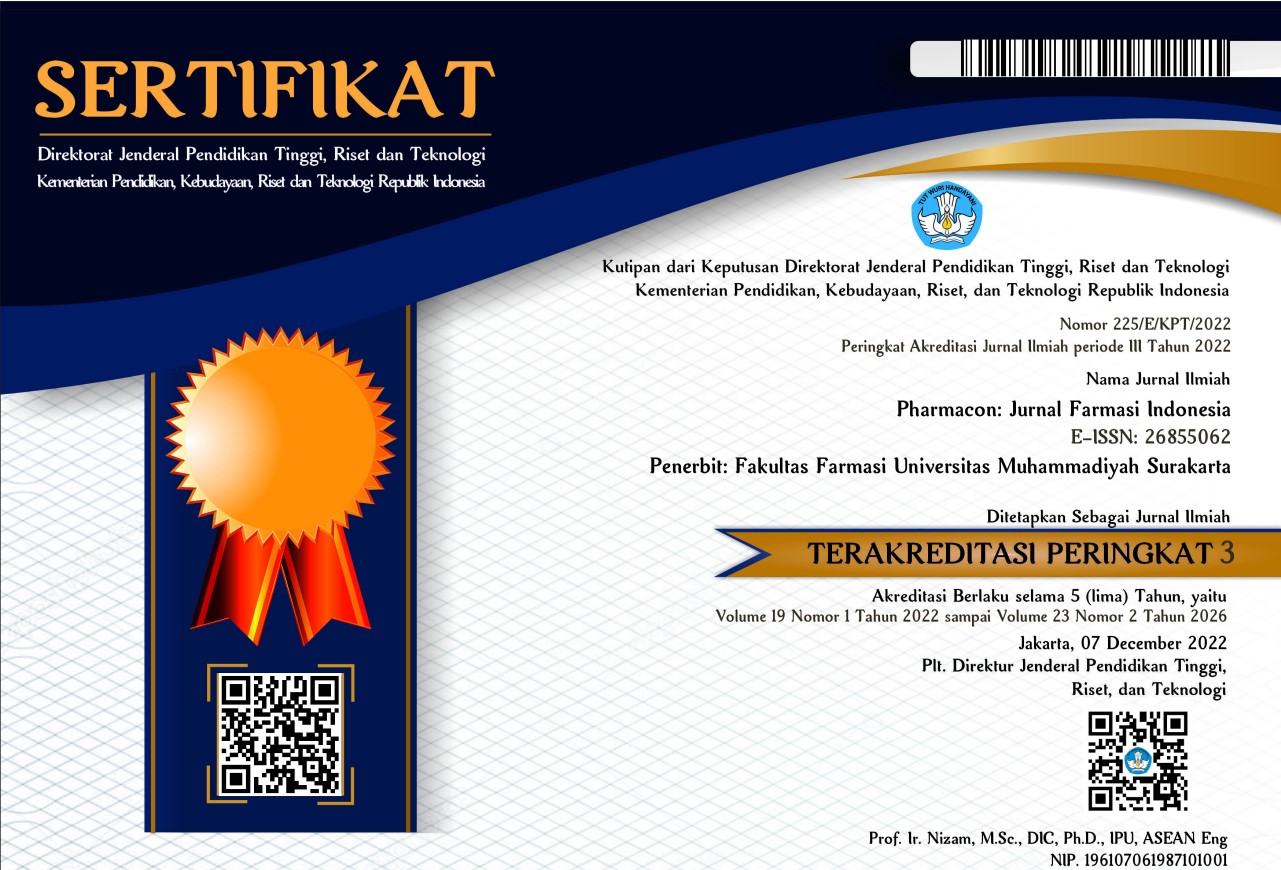The Relationship Between Rational Antibiotic Use and Theurapeutic Outcomes in Patients with Community Acquired Pneumonia
DOI:
https://doi.org/10.23917/pharmacon.v22i1.11678Keywords:
antibiotics, community acquired pneumonia , Gyssens Method, rationality , therapeutic outcomesAbstract
Pneumonia is an infection caused by microorganisms. Antibiotics are one of the treatments given to patients with pneumonia caused by bacterial infections. Rational use of antibiotics will prevent resistance. This study aims to determine the relationship between the rationality of antibiotic use and therapeutic outcomes in community-acquired pneumonia patients. We used a cross-sectional study and retrospectively collected data using purposive sampling. The inclusion criteria are non-ICU community pneumonia patients have complete medical record data, while the exclusion criteria are patients who died or had other infections. We evaluated the rationality of antibiotics using the Gyssens method. Based on the results, there are 240 patients, with 210 patients receiving rational therapy and 30 patients receiving irrational antibiotics. Based on the results, 6 patients did not receive antibiotics on time, 4 patients received the wrong dose, 2 patients did not get the correct interval, 16 patients received a dose that was too short, and 2 patients were prescribed alternative antibiotics that were more effective. The results of the analysis showed that there is a significant relationship between the rationality of antibiotic use and the therapeutic outcomes of community-acquired pneumonia patients (p-value < 0.001; OR 14.36).
Downloads
References
Bestari, M. P., & Karuniawati, H. (2019). Evaluation of the rationality and effectiveness of antibiotic use in pediatric pneumonia patients at the inpatient installation of Central Java Central Hospital. Pharmacon: Indonesian Journal of Pharmacy, 14(2), 62-71. http://dx.doi.org/10.23917/pharmacon.v14i2.6524 .
Hardiana, I., Laksmitawati, D. R., & Ramadaniati, H. U. (2021). Evaluation of antibiotic use in community-acquired iypneumonia patients at the inpatient unit of RSPAD Gatot Subroto. Journal of Pharmacy and Pharmacology, 25(1), 1-6. DOI: https://doi.org/10.20956/mff.v25i1.11555
Ilmi, T., Yulia, R., & Herawati, F. (2020). Evaluation of Antibiotic Use in Pneumonia Patients at Tulungagung Regional General Hospital. Indonesian Journal of Pharmaceutical Innovation, 1(2), 102-112. http://dx.doi.org/10.30737/jafi.v1i2.903.
Jiang, C., Chen, Q., & Xie, M. (2020). Smoking increases the risk of infectious diseases: A narrative review. Tobacco induced diseases, 18, 60. 10.18332/tid/123845
Kresnawati, V., Herawati, F., Crisdiono, H., & Yulia, R. (2021). Analysis of Antibiotic Use in Community-Acquired Pneumonia Patients at Kediri District Hospital. MPI (Media Pharmaceutica Indonesiana), 3(4), 245-252. https://doi.org/10.24123/mpi.v3i4.4468 .
Leilani, F. R., Andarini, I., & Nugroho, I. D. (2023). Relationship between Body Mass Index and Asthma Control Level in Pediatric Asthma Patients at Dr. Moewardi Surakarta Hospital. Plexus Medical Journal, 2(3), 100-108. https://doi.org/10.20961/plexus.v2i3.593 .
Ministry of Health. (2021). National Guidelines for Medical Services for the Management of Pneumonia in Adults, Ministry of Health of the Republic of Indonesia, 1–85.
Nurhikmawati, N., Ananda, S. R., Idrus, H. H., & Wisudawan, W. (2020). Characteristics of Hypertension Risk Factors in Makassar in 2017. Indonesian Journal of Health, 1(01), 53-73. https://doi.org/10.33368/inajoh.v1i01.12.
Pangestuti, T. I., Wahyono, D., & Nuryastuti, T. (2020). The Relationship Between the Appropriateness of Antibiotic Administration Based on Guidelines and Clinical Outcomes in Adult Patients with Mrsa (Methicillin Resistant Staphylococcus Aureus) Infections in Inpatients at Dr. Sardjito General Hospital, Yogyakarta. Pharmaceutical Magazine, 16(1), 50-57. https://doi.org/10.22146/farmaseutik.v16i1.48051
PDPI. (2014). Pneumonia: Guidelines for Diagnosis and Medical Management, Indonesian Doctors Association, (19), 19–22, Jakarta, Indonesia. 10.7454/jpdi.v6i2.335
Prakoso, D., Posangi, J., & Nangoy, E. (2018). Overview and Rationale of Antibiotic Use in Adult Patients with Community Acquired Pneumonia at Prof. Dr. RD Kandou Manado General Hospital, June 2017-May 2018. eBiomedik, 6(2). https://doi.org/10.35790/ebm.v6i2.22156.
Rumende, C. M., Chen, L. K., Karuniawati, A., Bratanata, J., & Falasiva, R. (2019). The Relationship Between the Accuracy of Antibiotic Administration Based on the Gyssens Flow and Clinical Improvement of Patients in Community-Acquired Pneumonia. Indonesian Journal of Internal Medicine.10.7454/jpdi.v6i2.335.
Sari, I. P., Nuryastuti, T., Asdie, R. H., Pratama, A., & Estriningsih, E. (2017). Comparison of antibiotic therapy patterns in Community-Acquired Pneumonia (CAP) in Type A and B Hospitals. Journal of Pharmaceutical Management and Services, 7(4), 168-174. e-ISSN: 2443-2946. https://doi.org/10.22146/jmpf.33261.
Setiadi, D. A., Widyati, W., & Yakti, K. (2020). Effectiveness and Safety of Furosemide Continuous Infusion Doses of 10 and 20 mg/hour in Chronic Kidney Disease Patients with Fluid Overload Syndrome accompanied by Hypoalbuminemia at Abdul Wahab Sjahranie Hospital. Journal of Pharmacy Science and Practice, 7(1), 8-14. https://doi.org/10.33508/jfst.v7i1.2390 .
Syahniar, R., Nabila, A. N., Kharisma, D. S., & Akbar, M. A. (2021). Comparison between monotherapy and combination therapy among inpatients with community-acquired pneumonia. Jurnal Ilmiah Farmasi, 17(1), 56-63. https://doi.org/10.20885/jif.vol17.iss1.art6
Tambun, S. H., Puspitasari, I., & Laksanawati, I. S. (2019). Evaluation of clinical outcomes of antibiotic therapy in hospitalized children with community acquired pneumonia. Journal of Management and Pharmacy Practice, 9(3), 213-224. 10.22146/jmpf.47915.
Utsman P. and Karuniawati H. (2020). Evaluation of Antibiotic Use in Toddler Patients of Pneumonia at “Y” Hospital of “X” City in 2016, Indonesian Journal of Pharmacy, 17 (1), 45–53. Available at: http://journals.ums.ac.id/index.php/pharmacon.
Widiyastuti, A., Kumala, S., Utami, H., & Pratama, A. (2023). The relationship between rationality of antibiotic use and clinical outcomes of hospitalized community-acquired pneumonia patients. Journal of Health, 14(1), 109-116. https://doi.org/10.26630/jk.v14i1.3483.
Yusuf, M., Auliah, N., & Sarambu, H. E. (2022). Evaluation of Antibiotic Use with the Gyssens Method in Pneumonia Patients at Bhayangkara Hospital Kupang July–December 2019 Period. Indonesian Journal of Pharmaceutical Research, 4(2), 215-229. https://doi.org/10.33759/jrki.v4i2.243.
Zekavat, S. M., Honigberg, M., Pirruccello, J. P., Kohli, P., Karlson, E. W., Newton-Cheh, CHongyu Zhao, and Pradeep Natarajan. (2021). Elevated blood pressure increases pneumonia risk: epidemiological association and mendelian randomization in the UK Biobank. Med, 2(2), 137-148. https://doi.org/10.1016/j.medj.2020.11.001.









